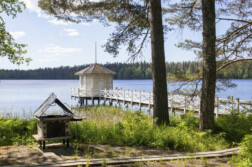INTRODUCTION
Natura 2000 is a network of protected areas established by the European Union (EU) to conserve and protect Europe’s most valuable and threatened species and habitats. It is based on the Birds Directive and the Habitats Directive, which are two key pieces of EU environmental legislation.
In the case of Finland, Evo refers to Evo Natura 2000 site, which is in the Häme region of southern Finland. Evo is a diverse and ecologically major area that encompasses forests, lakes, mires, and wetlands. It is home to a wide range of plant and animal species, including several rare and endangered ones.
The main objective of establishing the Natura 2000 site in Evo is to protect and preserve the natural habitats and species found in the area. This involves implementing conservation measures, managing human activities, and ensuring the sustainable use of natural resources. The site is also open to visitors who can explore and appreciate the unique natural beauty and biodiversity it offers while respecting the conservation goals of the Natura 2000 network.
What are the areas you can find in Natura 2000 site of Evo in Finland.
In the Natura 2000 site of Evo in Finland, you can find several types of habitats and areas that are protected and conserved. Some of the key areas and examples of habitats found in Evo include:
1. Forests: Evo is known for its extensive forests, including both coniferous and deciduous forests. These forests provide habitats for a wide range of plant and animal species, such as spruce, pine, birch, and various mosses and lichens.
2. Lakes: The site includes several lakes, such as Lake Iso-Roine and Lake Pääjärvi. These lakes support diverse aquatic ecosystems and are home to fish species like perch, pike, and roach. They also attract various bird species, including waterfowl and wader.
3. Mires and Wetlands: Evo has several mires and wetlands, which are important for their unique plant communities and as breeding grounds for many bird species. These areas include raised bogs, fens, and swamp forests, with species like cranberries, bog rosemary, and various sedges and mosses.
4. Rivers and Streams: The site is also traversed by rivers and streams, such as the Evo Joki River. These water bodies provide habitats for fish species like brown trout and grayling and support riparian vegetation and associated wildlife.
5. Cultural Landscapes: Evo has areas of cultural and historical significance, including old agricultural landscapes, traditional meadows, and historical sites. These areas contribute to the overall biodiversity and cultural heritage of the site.
Here are some examples we can find in the Evo Natura 2000 site;
Examples of species found in Evo Natura 2000 site include the Siberian flying squirrel, European nightjar, black-throated diver, and various orchid species. These are just a few examples, as Evo is known for its rich biodiversity and ecological importance.
LAMMI BIOLOGICAL STATION
Lammi Biological Station is a research facility of the University of Helsinki located in, Finland. It focuses on studying various aspects of biodiversity and ecology.
Specifically, some of the research topics conducted at Lammi Biological Station relating to Natura 2000 in Evo include:
1. Habitat studies: Researchers study the different habitats found within the Natura 2000 areas in Evo, such as forests, wetlands, and meadows. They assess the quality, distribution, and conservation status of these habitats to ensure their protection.
2. Species monitoring: The station carries out monitoring programs to assess the abundance, distribution, and health of various plant and animal species found in the Natura 2000 areas. This information helps in identifying conservation needs and implementing appropriate management strategies.
3. Ecosystem functioning: Lammi Biological Station investigates the ecological processes and interactions within the Natura 2000 areas. This includes studying nutrient cycles, energy flow, and the impacts of environmental changes on ecosystem functioning.
4. Conservation management: The research conducted at the station also aims to provide scientific knowledge and recommendations for the effective management and preservation of the Natura 2000 areas in Evo. This may involve assessing the impacts of human activities, developing conservation strategies, and implementing restoration measures.
Overall, Lammi Biological Station’s research contributes to the understanding and conservation of biodiversity within the Natura 2000 areas in Evo, helping to ensure the long-term sustainability of these valuable ecosystems.




